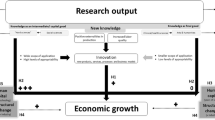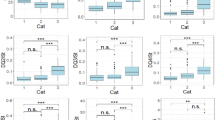Abstract
The article introduces a relational input–output model for the productivity analysis of university research. The comparative analyses focus on top university research in hard sciences from 4 East Asian countries (Hong Kong, Singapore, South Korea, Taiwan) and 4 North European countries (Denmark, Finland, Norway, Sweden), universities of which get altogether 95 recognitions in the HEEACT Top 300 rankings in the Natural Sciences (Sci), Technology (Tec) or Clinical Medicine (Med). According to productivity ratings (A0, A, A+, A++), Taiwan receives 10 A++ ratings (Sci 5, Tec 5), Sweden 9 (Sci 4, Med 4, Tec 1) and Hong Kong 9 (Tec 4, Med 2, Sci 1). The smallest numbers of A++ ratings are found in Norway, 1 (Med) and Finland 3 (all in Med). The only university with an A++ rating in the top of all three fields is the National University of Singapore. The Pohang University of Science and Technology (South Korea) and the National Tsing Hua University (Taiwan) are exceptionally productive in Sci and Tec; Karolinska Institutet (Sweden) and the University of Helsinki (Finland) belong to the top in Med. Even though Northern European countries are ranked higher in the ‘knowledge economy indicators’, East Asians fare better by indicators of learning outcomes and by productivity of university research in Natural Sciences and Technology; North European countries are stronger in Clinical Medicine.





Similar content being viewed by others
Notes
Iceland was the only Scandinavian country to be left out, because its universities do not appear in the HEEACT Top 300 field ranking in hard sciences which forms our output database.
In our article we follow the classification of the HEEACT Top 300 Field-based Ranking database for the ‘hard sciences’ i.e. Natural Sciences (Chemistry, Geosciences, Mathematics, Physics, Space sciences, Psychology); Clinical Medicine (Clinical Medicine, Psychiatry) and Technology (Computer Science, Engineering, Materials Science). This HEEACT classification, in its turn, relies on subject categories drawn from SCI and SSCI (altogether 132 SCI and SSCI subject categories are included under the three ‘hard sciences’).
For a detailed guide on utilizing bibliometric analyses in research evaluation see Moed (2005).
Input data for the Chonbuk National University (Tec) and the University of Ulsan (Med) from South Korea, Malmö University (Med) from Sweden as well as Chang Gung University (Med) and the National Chung Hsing University (Tec) from Taiwan have been complemented from national and local sources due to their unavailability in the QS.
To calculate disposable man years DMY from a known total amount of resources (TF) and a known total amount of ‘recognized units’ (in this case 161 from which 95 in Sci, Tec or Med). we apply the following group of equations.
$$ \left\{ {\begin{array}{*{20}l} {\begin{array}{*{20}l} {\alpha_{ij} a_{\text{AGR}} F_{\text{AGR}} + \alpha_{ij} a_{\text{MED}} F_{\text{MED}} + \alpha_{ij} a_{\text{TEC}} F_{\text{TEC}} + \alpha_{ij} a_{\text{SCI}} F_{\text{SCI}} + \alpha_{ij} a_{\text{SOC}} F_{\text{SOC}} + \alpha_{ij} a_{\text{LIFE}} F_{\text{LIFE}} = TF_{i} } \\ {a_{\text{AGR}} + a_{\text{MED}} + a_{\text{TEC}} + a_{\text{SCI}} + a_{\text{SOC}} + a_{\text{LIFE}} = 1} \\ \end{array} } \\ {\sum\nolimits_{i = 1}^{52} {\sum\nolimits_{j = 1}^{6} {\alpha_{ij} = {\text{TF}}} } } \\ \end{array} } \right. $$where F k denotes number of faculty in field k, ak denotes field k’s share of the total research man-years (1) and α ij denotes university i’s unit j’s share of the total faculty (TF). DMYs by fields (6) and universities (52) are obtained by solving the group of equations for each α ij .
References
Abramo, G., Cicero, T., & D’Angelo, C. A. (2012). Revisiting size effects in higher education research productivity. Higher Education, 63(6), 701–717.
Abramo, G., D’Angelo, C. A., & Di Costa, F. (2010). Testing the trade-off between productivity and quality in research activities. Journal of the American Society for Information Science and Technology, 61(1), 132–140.
Abramo, G., D’Angelo, C. A., & Di Costa, F. (2011). A national-scale cross-time analysis of university research performance. Scientometrics, 87(2), 399–413.
Altbach, P. (2006). The dilemmas of ranking. International Higher Education, 42, 2–3.
Billaut, J.-C., Bouyssou, D., & Vincke, P. (2010). Should you believe in the Shanghai ranking? An MCDM view. Scientometrics, 84(1), 237–263.
Bulle, N. (2011). Comparing OECD educational models through the prism of PISA. Comparative Education, 47(4), 503–521.
Crespi, G. A., & Geuna, A. (2008). An empirical study of scientific production: a cross country analysis, 1981–2002. Research Policy, 37(4), 565–579.
Dehon, C., McCathie, A., & Verardi, V. (2010). Uncovering excellence in academic rankings: a closer look at the Shanghai ranking. Scientometrics, 83(2), 515–524.
EUA. (2011). Global University Rankings and their Impact. EUA Report on Rankings, 2011. Rauhvargers, Andrejs. Brussels: European University Association.
Florian, R. V. (2007). Irreproducibility of the results of the Shanghai academic ranking of world universities. Scientometrics, 72(1), 25–32.
GCI (2011–2012) The Global Competitiveness Index 2011–2012 rankings, http://www3.weforum.org/docs/WEF_GCR_CompetitivenessIndexRanking_2011-12.pdf.
Hazelkorn, E. (2011). Rankings and the Reshaping of Higher Education. The Battle for world-class excellence. London: Palgrave Macmillan.
Hazelkorn, E. (2012) The Effects of Rankings on Student Choices and Institutional Selection. Forthcoming in B.W.A. Jongbloed and J.J. Vossensteyn (Eds.), Access and Expansion Post-Massification. Opportunities and Barriers to Further Growth in Higher Education Participation, Routledge.
HEEACT Performance Ranking of Scientific Papers for World Universities, home page: http://ranking.heeact.edu.tw/en-us/2011/Page/Methodology. Accessed 25 May 2012.
Herbst, M. (2007). Financing Public Universities. Higher Education Dynamics, vol. 18. Berlin: Springer.
Hicks, D. (2012). Performance-based university research funding systems. Research Policy, 41(2), 251–261.
IDI (2011) Measuring the Information Society 2011. Geneva: International Telecommunication Union, ITU. http://www.itu.int/net/pressoffice/backgrounders/general/pdf/5.pdf.
Kauppi, N., & Erkkilä, T. (2011). The struggle over global higher education: actors, institutions, and practices. International Political Sociology, 5(3), 314–326.
KEI (2012) Knowledge Economy Index (KEI) 2012 Rankings, http://siteresources.worldbank.org/INTUNIKAM/Resources/2012.pdf.
Kivinen, O. & Hedman, J. (2004). Yliopistolaitoksen tuloksellisuus Suomessa 1999–2003. Yliopistojen panokset ja tulokset tieteenaloittaisessa tarkastelussa. Research Unit for the Sociology of Education (RUSE). Research report 64. Turku: University of Turku.
Kivinen, O., & Hedman, J. (2008). World-wide University Rankings—A Scandinavian approach. Scientometrics, 74(3), 391–408.
Kivinen, O., Hedman, J., & Peltoniemi, K. (2008). Productivity of research by disciplines in Finland in 2002–2006. Research Unit for the Sociology of Education (RUSE), Research report 73. Turku: University of Turku.
Kivinen, O., Hedman, J., & Peltoniemi, K., (2011). Towards the Best A++Rating. Productivity of Research and Teaching in Finnish Universities. Research Unit for the Sociology of Education (RUSE), 2011. Turku: University of Turku, 47 pages. Online at: http://www.doria.fi/handle/10024/69353.
Luwel, M. (2004). The Use of input data in the performance analysis of R&D systems. Potentialities and Pitfalls. In H. F. Moed, W. Glänzel, & U. Schmoch (Eds.), Handbook of Quantitative Science and Technology Research: The Use of Publication and Patent Statistics in Studies of S & T Systems (pp. 315–338). Dordrecht: Kluwer Academic Publishers.
Macri, J., & Sinha, D. (2006). Rankings methodology for international comparisons of institutions and individuals: an application to economics in Australia and New Zealand. Journal of Economic Surveys, 20(1), 111–156.
Marginson, S., & van der Wende, M. (2009) The New Global Landscape of Nations and Institutions. In: Higher Education to 2030. Volume 2: Globalization. Paris: OECD Publishing, 17–62.
Merisotis, J., & Sadlak, J. (2005). Higher education rankings: evolution, acceptance, and dialogue. Higher Education in Europe, 30(2), 97–101.
Moed, H. F. (2005). Citation Analysis in Research Evaluation. Dordrecht: Springer.
Moed, H.F., Glänzel, W., & Schmoch U. (2004). Editor’s Introduction. In: Moed, H.F., Glänzel, W., & Schmoch U. (eds.) Handbook of Quantitative Science and Technology Research: The Use of Publication and Patent Statistics in Studies of S & T Systems. Dordrecht: Kluwer Academic Publishers, 1–15. Electronic version: (2005) Published by Springer Science + Business Media, Inc. http://www.springerlink.com/content/978-1-4020-2702-4#section=546116&page=1&locus=0.
O’Leary, J., Quacquarelli, N., & Ince, M. (2010). Top Universities Guide 2010. 4th revised and updated edition exclusively featuring the QS World University Rankings. London: QS Quacquarelli Symonds Limited.
van Raan, A. F. J. (2005a). Fatal attraction: conceptual and methodological problems in the ranking of universities by bibliometric methods. Scientometrics, 62(1), 133–143.
van Raan, A. F. J. (2005b). Academic ranking of world universities using scientometrics—A comment to the “Fatal Attraction”—Reply. Scientometrics, 64(1), 111–112.
Academic Ranking of World Universities (ARWU) home page: http://www.shanghairanking.com/. Accessed 25 May 2012.
Leiden Ranking home page: http://www.leidenranking.com/. Accessed 25 May 2012.
QS World University Rankings home page: http://www.topuniversities.com. Accessed 25 May 2012.
Author information
Authors and Affiliations
Corresponding author
Rights and permissions
About this article
Cite this article
Kivinen, O., Hedman, J. & Kaipainen, P. Productivity analysis of research in Natural Sciences, Technology and Clinical Medicine: an input–output model applied in comparison of Top 300 ranked universities of 4 North European and 4 East Asian countries. Scientometrics 94, 683–699 (2013). https://doi.org/10.1007/s11192-012-0808-4
Received:
Published:
Issue Date:
DOI: https://doi.org/10.1007/s11192-012-0808-4




